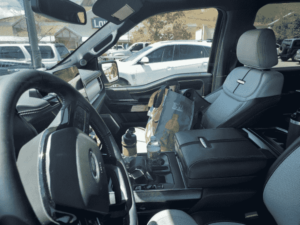
Never until today had I seen a pickup truck that lacked a grille. Indeed over the years I had come to realize that motor vehicles differ from one to the next in the “gapingness” of the openings in the grille. Motor vehicles that are more, shall we say, manly, tend to have grilles with larger and more gaping openings. And here is an otherwise presumably extremely manly Ford pickup truck, but with … wait for it … no grille at all. There is only a sort of decorative panel in its place. Who can guess where I am going with this? What vehicle is this? Yes, perhaps some readers already know where I am going with this. What you see here is a vehicle that I had never before seen in person. This, dear reader, is the elusive Ford F-150 Lightning. This is the electric vehicle pickup truck made by Ford. This is the vehicle which, depending on the options package that you might have selected, has extremely manly electrical receptacles that can power things like an electric arc welder. This is the vehicle which, if connected to a transfer switch on your house, can power your house for anywhere from one to three days during a loss of power from the electrical grid. This is the vehicle which, if you recall, was piloted by our current sitting president (in a large parking lot, fortunately) accelerating from zero to 60 in something like 2.5 seconds. Which, by the way, an ordinary gasoline-powered pickup truck would not be able to do because it does not have that much low-end torque.
This is the Ford vehicle which, if you put down a deposit and place an order, might be delivered to you in two years. Yes, the Ford F-150 Lightning is sold out, and it is so sold out that there is by now a two-year waiting list. But somebody somewhere managed to be among the first to buy one. And they parked it in this parking lot, and I encountered it.

I feel I have no choice but to share with my loyal readers that what I spied in the shotgun seat was a shopping bag from Whole Foods. My chief reason for mentioning this is that probably the reason why the owner of truck was at the Whole Foods store is that it has an EV charger that is free to use. Yes, it is like going to a gas station and pumping some gas and having the manager of the gas station walk out to where you are pumping the gas, and explain that today you will not have to pay for the gasoline.
Indeed if I click on an app to look for EV charging stations, I can find no fewer than four free EV charging stations within a five-minute drive from the place where this F-150 pickup truck was parked. One of which was at the Whole Foods grocery store. Four places that are quite nearby and that are very much like going to a gas station and being told that today the gasoline is free.

As a former owner of a Tesla Model 3 (also without a grill), I can tell you that such fully electric vehicles are beautiful to drive, charge, and maintain if you mostly need them for local driving, where you can charge at home or occasionally pick up a free charge at an accommodating retailer like Whole Foods. However, they are quite inconvenient for long trips. Even for a Tesla, which gets to use the best charger network in the country, by far, trips must be carefully planned, avoid many rural areas that don’t have chargers for hundreds of miles, involve charging stops that exceed 30 minutes plus wait time for an available port, and deal with outages of one or more ports at charging stops (sometimes all of them). If a gasoline station has no power and cannot pump fuel, you can probably travel to another one five or ten miles away and fill up in a few minutes. If a charging station is in a power outage area, the next one may be 50 miles away or more, and unreachable with your remaining range. So you wait until power is restored. My current plug-in hybrid is a much better vehicle for local electric driving, while retaining the ability to jump on the highway and take a long trip. We are a very long way from electric vehicles supplanting gasoline/diesel vehicles, realistically, and we still have substantial problems to overcome before electric vehicles offer anywhere near the convenience and versatility of the former. Not to mention the overhaul needed for our electrical grid to support a substantial number of electric vehicles.
Of course you are right about your points. For example I drive a Tesla, and when I did a cross-country trip some months ago to go visit my sister, I had the Tesla supercharger network available almost all of the way. But not for the last 300 miles or so to my sister’s home. Her home was in a desert, so to speak, of EV chargers of any kind. The way it would have worked out (had I not planned ahead) is I would have arrived at her home and then I would not have been able to drive the car any more. The battery would have been run all the way down.
So I had to plan ahead. I went to Amazon and ordered a Level-2 charger and had it delivered to her home in advance of my arrival. I also brought with me a length of 6-gauge wire and an appropriate 50-amp circuit breaker. When I arrived, I installed the charger at her home. This is what made it so that I was able to charge up my dead-battery car and drive away from her home at the end of my visit.
For some people who have daily driving activities around town, maybe a commute to and from a job, or local errands, the (non-Tesla) EV might be a good idea. This works out especially well for a person who lives in a private home and can install a level-2 charger in the garage. Charging up at night (when the electricity is inexpensive) can be an ideal way to charge up the car.
I realize you love your hybrid car. And I get it that for people who demand that some single vehicle must work for the one cross-country trip that they do in a year, and who also want that vehicle to work for the other 360 days in the year of local driving, the hybrid car might be the only workable choice. But think of the number of moving parts in the drive train of an ICE car. Maybe 3000. Now think of the number of moving parts in the drive train of an EV. Maybe 20. What is the number of moving parts in the drive train of your hybrid car? Guess what? You get to add 3000 and 20 and add on 20 more parts for the hybridization. 3040 parts. Many more parts to fail. Not only that, you still get to do oil changes and replace the engine oil filter and fan belts and the engine air filter. And maybe the spark plugs. And you get to do lube jobs. Yes, with the hybrid car you get many of the drawbacks of the ICE car plus more.
But I get it. The person who in July of 2022 decides to head out the door and go shopping and come home with an EV will probably not succeed. Most makes and models of EVs now have wait lists of anywhere from half a year to two years. If you call a dealership and they say they have one EV in stock and you hop in the car to go over and purchase it, I can promise you it will be gone by the time you get there because someone else snapped it up before you got there. And probably paid a few thousand dollars over list price to get it. So yes, the person who in July of 2022 decides to head out the door and go shopping and come home with something to reduce the pain of expensive gasoline will almost certainly have to settle for a hybrid car. That’s just how it is.
Nobody had to do an overhaul of the electrical grid for me to charge up my EV. I have lots of solar panels on my roof and usually when I am charging up my car, it comes from sunlight that lands on the roof.
I don’t think you are accurately characterizing what it is like at Tesla supercharging stations. In general, when I pass by any Tesla supercharging station, there are idle charging positions. Not once in any car trip, local or cross-country, have I had to wait for a charging position to open up at a Tesla supercharging station, for me to be able to start charging. You talk about charging stops that exceed 30 minutes. Yes, that can happen. But here is the driving and charging itinerary that popped out of the Tesla trip planner for a drive from my office to yours. Only one of the charging stops exceeds 30 minutes.
Start Westminster, CO